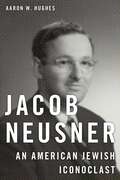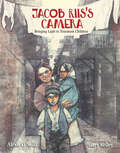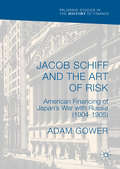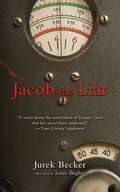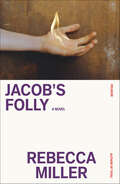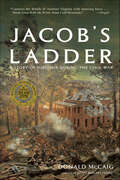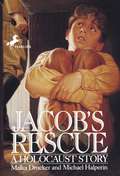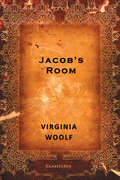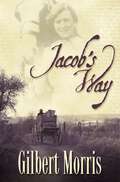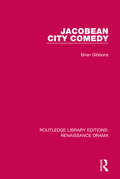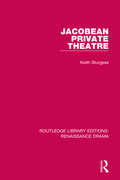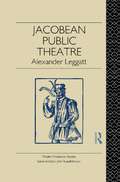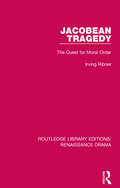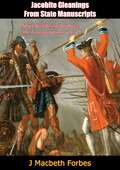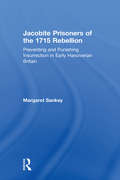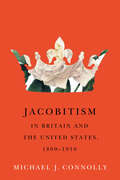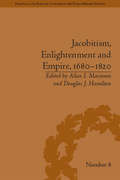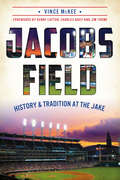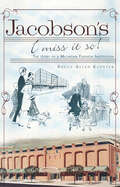- Table View
- List View
Jacob Neusner: An American Jewish Iconoclast (Key Thinkers In The Study Of Religion Ser.)
by Aaron W HughesBiography: Neusner is a social commentator, a post-Holocaust theologian, and an outspoken political figure. Jacob Neusner (born 1932) is one of the most important figures in the shaping of modern American Judaism. He was pivotal in transforming the study of Judaism from an insular project only conducted by—and of interest to—religious adherents to one which now flourishes in the secular setting of the university. He is also one of the most colorful, creative, and difficult figures in the American academy. But even those who disagree with Neusner’s academic approach to ancient rabbinic texts have to engage with his pioneering methods. In this comprehensive biography, Aaron Hughes shows Neusner to be much more than a scholar of rabbinics. He is a social commentator, a post-Holocaust theologian, and was an outspoken political figure during the height of the cultural wars of the 1980s. Neusner’s life reflects the story of what happened as Jews migrated to the suburbs in the late 1940s, daring to imagine new lives for themselves as they successfully integrated into the fabric of American society. It is also the story of how American Jews tried to make sense of the world in the aftermath of the extermination of European Jewry and the subsequent creation of the State of Israel in 1948, and how they sought to define what it meant to be an American Jew. Unlike other great American Jewish thinkers, Neusner was born in the U.S., and his Judaism was informed by an American ethos. His Judaism is open, informed by and informing the world. It is an American Judaism, one that has enabled American Jews—the freest in history—to be fully American and fully Jewish.
Jacob Riis's Camera: Bringing Light to Tenement Children
by Alexis O'NeillThis revealing biography of a pioneering photojournalist and social reformer Jacob Riis shows how he brought to light one of the worst social justice issues plaguing New York City in the late 1800s--the tenement housing crisis--using newly invented flash photography.Jacob Riis was familiar with poverty. He did his best to combat it in his hometown of Ribe, Denmark, and he experienced it when he immigrated to the United States in 1870. Jobs for immigrants were hard to get and keep, and Jacob often found himself penniless, sleeping on the streets or in filthy homeless shelters. When he became a journalist, Jacob couldn't stop seeing the poverty in the city around him. He began to photograph overcrowded tenement buildings and their impoverished residents, using newly developed flash powder to illuminate the constantly dark rooms to expose the unacceptable conditions. His photographs inspired the people of New York to take action. Gary Kelley's detailed illustrations perfectly accompany Alexis O'Neill's engaging text in this STEAM title for young readers.
Jacob Schiff and the Art of Risk: American Financing of Japan's War with Russia (1904-1905) (Palgrave Studies in the History of Finance)
by Adam GowerJacob Henry Schiff (1847–1920), a German-born American Jewish banker, facilitated critical loans for Japan in the early twentieth century. Working on behalf of the firm of Kuhn, Loeb & Co., Schiff’s assertiveness in favour of Japan separated him from his fellow German Jewish financiers and the banking establishment generally. This book’s analysis differs from the consensus that Schiff funded Japan largely out of enmity towards Russia but rather sought to work with Japan for over thirty years. This was as much a factor in his actions surrounding the Russo-Japanese War (1904–1905) as his concern to thwart Russian antisemitism. Of interest to financial historians alongside Japanese historians and academics of both genres, this book provides a lively and thoroughly researched volume that precisely focuses on Schiff’s mastery of banking.
Jacob Sigismund Beck's Standpunctslehre and the Kantian Thing-in-itself Debate
by Lior NitzanThis book examines the unique views of philosopher Jacob Sigismund Beck, a student of Immanuel Kant who devoted himself to an exploration of his teacher's doctrine and to showing that Kant's transcendental idealism is, contra to the common view, both internally consistent and is not a form of subjective idealism. In his attempt to explain away certain apparent contradictions found in Kant's system, Beck put forward a new reading of Kant's critical theory, a view, which came to be known as the Standpunctslehre, the Doctrine of the Standpoint. Author Lior Nitzan reconstructs, step by step, the historical development of Beck's doctrine. He shows how Beck's unique view is drastically different from that of his contemporaries and presents the relevance of Beck to contemporary debates about the proper interpretation of Kant's notion of objectivity, the refutation of idealism and the role of the thing in itself in Kant's transcendental idealism. In doing so, Nitzan presents a defense of Beck's radical perspective of Kant's theory and claims that some of Kant's negative responses to it may in fact be due more to the adversary academic environment at the time than to Kant's true, well considered, opinion. Jacob Sigismund Beck's Standpunctslehre challenges the two dominant schools in the interpretation of Kant's transcendental idealism--the "two world" and the "two aspect" view. It presents a new way of understanding Kant's transcendental idealism, according to which the thing in itself plays no positive role in relation to the possibility of experience. Moreover, it claims that eliminating the thing in itself as the ultimate object of knowledge is not to admit idealism but in fact is the only way to consistently uphold realism. In addition, the book also addresses the question why, assuming that the proposed interpretation is correct, Kant had chosen not to make his true intentions clear.
Jacob The Liar
by Jurek BeckerCut off from all news of the war along with thousands of fellow prisoners, Jacob Heym accidentally overhears a radio broadcast that reveals the Red Army's advancement and is forced to tell a series of lies in order to explain his knowledge.
Jacob Viner: Lectures in Economics 301
by Douglas A. Irwin Steven G. MedemaThis book presents, for the first time, a detailed transcription of Jacob Viner's Economics 301 class as taught in 1930. These lecture notes provide insight into the legacy of Jacob Viner, whose seminal contributions to fields such as international economics and the history of economics are well known, but whose impact in sparking the revival of Marshallian microeconomics in the United States via his classroom teaching has been less appreciated.Generations of graduate students at the University of Chicago have taken Economics 301. The course has been taught by such luminaries as Milton Friedman and Gary Becker, and remains an introduction to the analytical tools of microeconomics and the distinctive Chicago way of thinking about the market system. This demanding and rigorous course first became famous in the 1930s when it was taught by Jacob Viner.When read in tandem with the Transaction editions of Milton Friedman's Price Theory, Frank Knight's The Economic Organization, and Gary Becker's Economic Theory, Viner's lectures provide the reader with important insights into the formative period of Chicago price theory. These recently discovered notes from Viner's class will be important for historians of economic thought and anyone interested in the origins of the Chicago School of Economics.
Jacob van Ruisdael’s Ecological Landscapes (Visual and Material Culture, 1300-1700)
by Catherine LevesqueThis book examines Jacob van Ruisdael's treatment of five subjects—dunes, grainfields, ruins, rushing water, and woodlands—that recur throughout his career. The paintings, though fictive, show close attention to the complexities of particular environments that can be fruitfully considered “ecological.” The pattern of Ruisdael’s reworking each environment and associated phenomena shows him as laboring over these themes. His work across media conveys something of his demanding and methodical procedure as he sought to achieve pictorially the force, temporality, vitality, and motion of nature. Ruisdael’s paintings decenter humankind within familiar yet reimagined landscapes. His ability to depict nature’s dynamism provided an alternative vision at a foundational moment when landscape, increasingly manipulated and controlled, was most often considered property and investment. His focus on the techniques and processes of his own work to render these entities was essential to his ecological perspective and invites a similar recognition from an attentive viewer.
Jacob's Folly: A Novel
by Rebecca MillerA luminous novel-funny and moving in equal measure-that shines with the author's unique talentsJacob's Folly is a rollicking, ingenious, saucy book, brimful of sparkling, unexpected characters, that takes on desire, faith, love, acting-and reincarnation. In eighteenth-century Paris, Jacob Cerf is a Jew, a peddler of knives, saltcellars, and snuffboxes. Despite a disastrous teenage marriage, he is determined to raise himself up in life, by whatever means he can. More than two hundred years later, Jacob is amazed to find himself reincarnated as a fly in the Long Island suburbs of twenty-first-century America, his new life twisted in ways he could never have imagined. But even the tiniest of insects can influence the turning of the world, and thanks to his arrival, the lives of a reliable volunteer fireman and a young Orthodox Jewish woman nursing a secret ambition will never be the same. Through the unique lens of Jacob's consciousness, Rebecca Miller explores change in all its different guises-personal, spiritual, literal. The hold of the past on the present, the power of private hopes and dreams, the collision of fate and free will: Miller's world-which is our own, transfigured by her clear gaze and by her sharp, surprising wit-comes brilliantly to life in the pages of this profoundly original novel.
Jacob's Ladder: A Story of Virginia During the War
by Donald McCaigWinner of the Michael Shaara Award for Excellence in Civil War Fiction A civil war saga that resonates with the bitter glory and human shame of the Confederacy.Jacob’s Ladder is a Civil War epic, a love story that pits the indomitable longing of the human heart against circumstances of racism, slavery, and war. Duncan Gatewood, seventeen and heir to the Gatewood plantation, falls in love with Maggie, a mulatto slave, who conceives a son, Jacob. Maggie and Jacob are sold south, and Duncan is packed off to the Virginia Military Institute. As Duncan fights for Robert E. Lee, Jesse—a Gatewood slave whose love for Maggie is unrequited—escapes north and enlists in Lincoln’s army, determined to confront his former masters, while Maggie finds herself living a life she never could have imagined as the wife of a blockade runner.From the interlocked lives of masters and slaves, Donald McCaig conjures a passionate and richly textured story in the heart of America’s greatest war. The destiny of these three compelling characters connect a Vicksburg brothel to a Richmond salon, the nightmare of a Confederate hospital to the lurid hell of battlefields at Fredericksburg and Chancellorsville.Winner of the John Eston Cook Award Winner of the Boyd Military Novel Award
Jacob's Rescue
by Malka Drucker Michael HalperinOnce Jacob Gutgeld lived with his family in a beautiful house in Warsaw, Poland. He went to school and played hide-and-seek in the woods with his friends. But everything changed the day the Nazi soldiers invaded in 1939. Suddenly it wasn't safe to be Jewish anymore. Jacob had to go live with complete strangers in order to stay safe. He had a new name, new siblings, new parents, and a new home. And he had to spend much of his time hiding. This is a true story of Jacob, his family, and survival.
Jacob's Room (Oxford World's Classics)
by Virginia WoolfA young man's life during the early years of the twentieth century is examined through the eyes of those closest to him. As Jacob Flanders grows from childhood to adulthood, the events and people that influence his life are examined solely through the perspectives of others, leading to an incomplete understanding of who Jacob really is.Virginia Woolf's third novel Jacob's Room is a character study that ponders how well any person can be known. Following the author's more conventional novels The Voyage Out and Night and Day, Jacob's Room is as an important modernist text, demonstrating Woolf's progression as a writer of modernist literature.Be it mystery, romance, drama, comedy, politics, or history, great literature stands the test of time. ClassicJoe proudly brings literary classics to today's digital readers, connecting those who love to read with authors whose work continues to get people talking. Look for other fiction and non-fiction classics from ClassicJoe.
Jacob's Shipwreck: Diaspora, Translation, and Jewish-Christian Relations in Medieval England
by Ruth NisseJewish and Christian authors of the High Middle Ages not infrequently came into dialogue or conflict with each other over traditions drawn from ancient writings outside of the bible. Circulating in Latin and Hebrew adaptations and translations, these included the two independent versions of the Testament of Naphtali in which the patriarch has a vision of the Diaspora, a shipwreck that scatters the twelve tribes. The Christian narrative is linear and ends in salvation; the Jewish narrative is circular and pessimistic. For Ruth Nisse, this is an emblematic text that illuminates relationships between interpretation, translation, and survival.In Nisse’s account, extrabiblical literature encompasses not only the historical works of Flavius Josephus but also, in some of the more ingenious medieval Hebrew imaginative texts, Aesop’s fables and the Aeneid. While Christian-Jewish relations in medieval England and Northern France are most often associated with Christian polemics against Judaism and persecutions of Jews in the wake of the Crusades, the period also saw a growing interest in language study and translation in both communities. These noncanonical texts and their afterlives provided Jews and Christians alike with resources of fiction that they used to reconsider boundaries of doctrine and interpretation. Among the works that Nisse takes as exemplary of this intersection are the Book of Yosippon, a tenth-century Hebrew adaptation of Josephus with a wide circulation and influence in the later middle ages, and the second-century romance of Aseneth about the religious conversion of Joseph’s Egyptian wife. Yosippon gave Jews a new discourse of martyrdom in its narrative of the fall of Jerusalem, and at the same time it offered access to the classical historical models being used by their Christian contemporaries. Aseneth provided its new audience of medieval monks with a way to reimagine the troubling consequences of unwilling Jewish converts.
Jacob's Way
by Gilbert Morris"The army makes a man hard sometimes. I remember a young girl no more than ten who gave me a glass of buttermilk just outside of Chancellorsville. I still remember that. I guess that’s all my life is. Some pictures fading out behind me, and there’s not much before me." Reisa listened as he spoke. She knew that he was a man who longed for goodness, and longed for friends, and perhaps even a wife and family. Finally she said, "I hope you find your way, Ben. God is real, and love is real." Fleeing a bloody pogrom that threatens their tiny Russian village, Reisa Dimitri and her grandfather, Jacob, sail the ocean to a new life in America. They are swiftly embraced by New York’s Jewish community. But God has other plans that will call them far from the familiar warmth and ways of their culture. Accompanied by their huge, gentle friend, Dov, Reisa and Jacob set out to make their living as traveling merchants in the post-Civil-War South. There, as new and unexpected friendships unfold, the aged Jacob searches for answers concerning the nature of the Messiah he has spent a lifetime looking and longing for. And there, the beautiful Reisa finds herself strangely drawn to Ben Driver--a man with a checkered past, a painful present, and a deadly enemy who will stop at nothing to destroy him. Fast-paced and tender by turn, Jacob’s Way is a heartwarming novel about human love, divine faithfulness, and the restoration of things that had seemed broken beyond repair.
Jacobean City Comedy (Routledge Library Editions: Renaissance Drama)
by Brian GibbonsThe first decade of the Jacobean age witnessed a sudden profusion of comedies satirizing city life; among these were comedies by Ben Jonson, John Marston and Thomas Middleton, as well as the bulk of the repertory of the newly-established children’s companies at Blackfriars and Paul’s. The playwrights self-consciously forged a new genre which attracted London audiences with its images of folly and vice in Court and City, and hack-writing dramatists were prompt to cash in on a new theatrical fashion. This study, first published in 1980, examines ways in which the Jacobean city comedy reflect on the self-consciousness of audiences and the concern of the dramatists with Jacobean society. This title will be of interest of students of Renaissance Drama, English Literature and Performance.
Jacobean Private Theatre (Routledge Library Editions: Renaissance Drama)
by Keith SturgessIn this scholarly and entertaining book, first published in 1987, the author tells the story of Jacobean private theatre. Most of the best plays written after 1610, including Shakespeare’s late plays such as The Tempest, were written for the new breed of private playhouses – small, roofed and designed for an aristocratic, literary audience, as opposed to the larger, open-air houses such as the Globe and the Red Bull, catering for a popular, ‘lowbrow’ audience. The author discusses the polarisation of taste and the effect it had on literary criticism and theatre history. This title will be of interest to students of English Literature, Drama and Performance.
Jacobean Public Theatre (Theatre Production Studies)
by Alexander LeggattJacobean Public Theatre recovers for the modern reader the acting, production and performance values of the public theatre of Jacobean London. It relates this drama to the popular culutre of the day and concludes with a close study of four important plays, including King Lear, which emerge in an unexpected light as the products of popular tradition.
Jacobean Tragedy: The Quest for Moral Order (Routledge Library Editions: Renaissance Drama)
by Irving RibnerThe work of dramatists such as George Chapman, Thomas Heywood, Cyril Tourneur, John Webster, Thomas Middleton and John Ford can profitably be studied as attempts to construct a new moral order in response to the absence or weakening of the religious sanction. In this study, first published in 1962, the author examines these texts in detail, and throws a great deal of light on the plays as plays. This title will be of interest to students of English Literature, Drama and Performance.
Jacobite Gleanings from State Manuscripts: Short Sketches Of Jacobites; The Transportations In 1745 (classic Reprint)
by J Macbeth ForbesThe Jacobite rising of 1745, also known as the Forty-five Rebellion or simply the '45, was an attempt by Charles Edward Stuart to regain the British throne for his father, James Francis Edward Stuart.Charles launched the rebellion on 19 August 1745 at Glenfinnan in the Scottish Highlands, capturing Edinburgh and winning the Battle of Prestonpans in September. At a council in October, the Scots agreed to invade England after Charles assured them of substantial support from English Jacobites and a simultaneous French landing in Southern England. On that basis, the Jacobite army entered England in early November, reaching Derby on 4 December, where they decided to turn back.Similar discussions had taken place at Carlisle, Preston and Manchester and many felt they had gone too far already. The invasion route had been selected to cross areas considered strongly Jacobite but the promised English support failed to materialise; they were now outnumbered and in danger of having their retreat cut off. The decision was supported by the vast majority but caused an irretrievable split between Charles and his Scots supporters. Despite victory at Falkirk Muir in January 1746, the Battle of Culloden in April ended the Rebellion and significant backing for the Stuart cause. Charles escaped to France, but was unable to win support for another attempt, and died in Rome in 1788.-WikiIn the aftermath of the rebellion the British exacted swift and often brutal revenge for the uprising with confiscations and deportations to the colonies.
Jacobite Prisoners of the 1715 Rebellion: Preventing and Punishing Insurrection in Early Hanoverian Britain
by Margaret SankeyThe Jacobite rebellion of 1715 was a dramatic but ultimately unsuccessful challenge to the new Hanoverian regime in Great Britain. It did, however, reveal serious fault lines in the political foundations of the new regime which enormously restricted the government's freedom of action in the suppression of the rebellion, and effectively made the treatment of the rebels in its aftermath the true test of the new dynasty's legitimacy and stability. Whilst the rulers of England had traditionally dealt harshly with internal rebellion, monarchs and their ministers had to find a delicate balance between showing the power of the regime through the candid exercise of force while maintaining their own reputation for justice and clemency. As such George I and his government had to tailor their reaction to the 1715 rebellion in such a way that it effectively discouraged further participation in Jacobite insurgency, undercut the rebels' ability to challenge the state, and made clear the regime's intention to use a firm hand in preventing rebellion. At the same time it could not cross the line into tyranny with excessive or sadistic executions and had to avoid giving offence to powerful magnates and foreign powers likely to petition for the lives of the captured rebels. To accomplish this feat, the Hanoverian Whig regime used a programme far more subtle and calculated than has generally been appreciated. The scheme it put into effect had three components, to put fear into the rank-and-file of the rebels through a limited programme of execution and transportation, to cripple the Catholic community through imprisonment and property confiscation, and, most crucially, to entertain petitions from members of the elite on behalf of imprisoned rebels. By following such a strategy of retribution tempered with clemency, this book argues that the Hanoverian regime was able to quell the immediate dangers posed by the rebellion, and bring its leaders back into the orbit of the government, beginning the process of reintegrating them back into political mainstream.
Jacobitism in Britain and the United States, 1880–1910 (McGill-Queen's Transatlantic Studies)
by Michael J. ConnollyIn the late nineteenth century a resurgent Jacobite movement emerged in Britain and the United States, highlighting the virtues of the Stuart monarchs in contrast to liberal, democratic, and materialist Victorian Britain and Gilded Age America. Compared with similarly aligned protest movements of the era – socialism, anarchism, nihilism, populism, and progressivism – the rise of Jacobitism receives little attention.Born in the Glorious Revolution of 1688, Jacobitism had been in steep decline since the mid-eighteenth century. But between 1880 and 1910, Jacobite organizations popped up across Britain, then spread to the United States, publishing royalist magazines, organizing public demonstrations, offering Anglo-Catholic masses to fallen Stuart kings, and praying at Stuart statues and tombs. Michael Connolly explains the rise and fall of Anglo-American Jacobitism, places it in context, and reveals its significance as a response to and a driver of the political forces of the period. Understanding the Jacobite movement clarifies Victorian Anglo-American anxiety over liberalism, democracy, industrialization, and emerging modernity. In an age when worries over liberalism are again ascendant, Jacobitism in Britain and the United States, 1880–1910 traces the complex genealogy of this unease.
Jacobitism, Enlightenment and Empire, 1680–1820 (Political and Popular Culture in the Early Modern Period #8)
by Douglas J HamiltonThe essays in this collection examine religion, politics and commerce in Scotland during a time of crisis and turmoil. Contributors look at the effect of the Union on Scottish trade and commerce, the Scottish role in tobacco and sugar plantations, Robert Burns’s early poetry on his planned emigration to Jamaica and Scottish anti-abolitionists.
Jacobs Beach: The Mob, the Fights, the Fifties
by Kevin MitchellThe story of New York in the fifties - of rat pack cool and the fading of the Mob's glamour, brilliantly told through the prism of Madison Square Garden. New York in the Fifties was the most interesting and most vibrant city in the world. New York gave the world a couple of other things too: one bloody and brutal but the king of sports, the other simply bloody and brutal. The Fifties were boxing's last real heyday. Never again would the sport be so glamorous or so popular. And that's where New York's other gift to the world--the Mob--came in. Gangsters have been around for boxing's entire history, but this time it was special. Most of the decade's major fights took place at boxing's spiritual home, Madison Square Garden, and most of the deals that made or ruined the lives of the era's many fine fighters were done on a famous strip of pavement across the road from the Garden: Jacobs Beach. And the man ruling that strip of pavement was a charming Italian murderer called Frankie Carbo.
Jacobs Field: History and Tradition at The Jake (Sports)
by Vince MckeeThe sports landscape changed in the spring of 1994 when the Cleveland Indians moved into their new stadium at the corner of Carnegie and Ontario. No longer the joke of the league, The Jake made them the jewel of baseball and helped revitalize a city and a fan base. For the first time ever, these interviews and stories from the players, managers and front office personnel give the inside scoop on what happened on the field, in the dugout and behind the scenes of this exciting time in Cleveland sports history. Get the best seat in the house for the most recent addition to the Tribe's celebrated legacy.
Jacobson's, I Miss It So!: The Story of a Michigan Fashion Institution (Landmarks)
by Bruce Allen KopytekJoin department store historian Bruce Allen Kopytek in this history of Jacobson's, a beloved Michigan institution for over 100 years. Winner of the Michigan Notable Book Award for 2012.Reenter the marvelous stores and meet the personalities who transformed Jacobson's from its humble Reed City origins to a staple of sophistication throughout Michigan and into the rest of the country. The brainchild of a retail genius, this deluxe specialty store gave customers a peerless social, shopping and dining destination. Experience anew the refined beauty of its Williamsburg-style Grosse Pointe store, the chic designer world of its Birmingham ensemble, or the charm and allure of its original Florida branch in Sarasota, revealing the secrets which made Jake's the dazzling store it was, and why it remains so profoundly missed by anyone who entered through its solid wooden doors.
Jacob’s Younger Brother: Christian-Jewish Relations after Vatican II
by Karma Ben-JohananA revealing account of contemporary tensions between Jews and Christians, playing out beneath the surface of conciliatory interfaith dialogue. A new chapter in Jewish-Christian relations opened in the second half of the twentieth century when the Second Vatican Council exonerated Jews from the accusation of deicide and declared that the Jewish people had never been rejected by God. In a few carefully phrased statements, two millennia of deep hostility were swept into the trash heap of history. But old animosities die hard. While Catholic and Jewish leaders publicly promoted interfaith dialogue, doubts remained behind closed doors. Catholic officials and theologians soon found that changing their attitude toward Jews could threaten the foundations of Christian tradition. For their part, many Jews perceived the new Catholic line as a Church effort to shore up support amid atheist and secular advances. Drawing on extensive research in contemporary rabbinical literature, Karma Ben-Johanan shows that Jewish leaders welcomed the Catholic condemnation of antisemitism but were less enthusiastic about the Church’s sudden urge to claim their friendship. Catholic theologians hoped Vatican II would turn the page on an embarrassing history, hence the assertion that the Church had not reformed but rather had always loved Jews, or at least should have. Orthodox rabbis, in contrast, believed they were finally free to say what they thought of Christianity. Jacob’s Younger Brother pulls back the veil of interfaith dialogue to reveal how Orthodox rabbis and Catholic leaders spoke about each other when outsiders were not in the room. There Ben-Johanan finds Jews reluctant to accept the latest whims of a Church that had unilaterally dictated the terms of Jewish-Christian relations for centuries.
